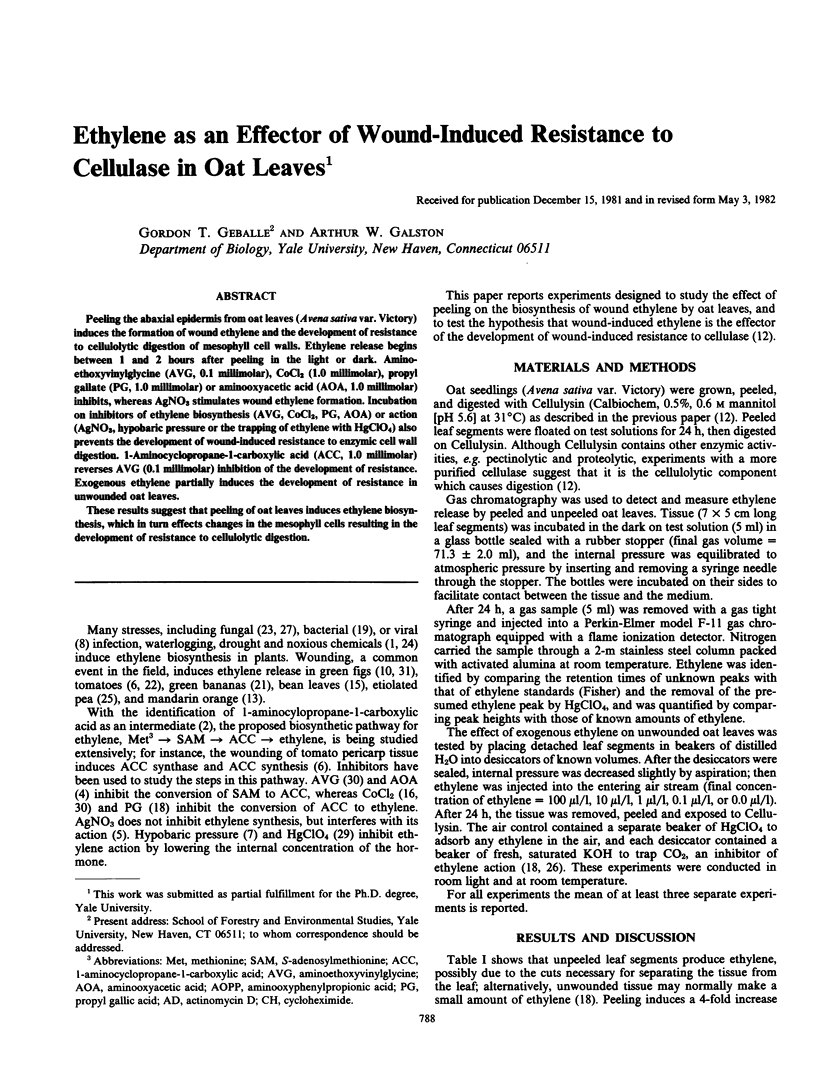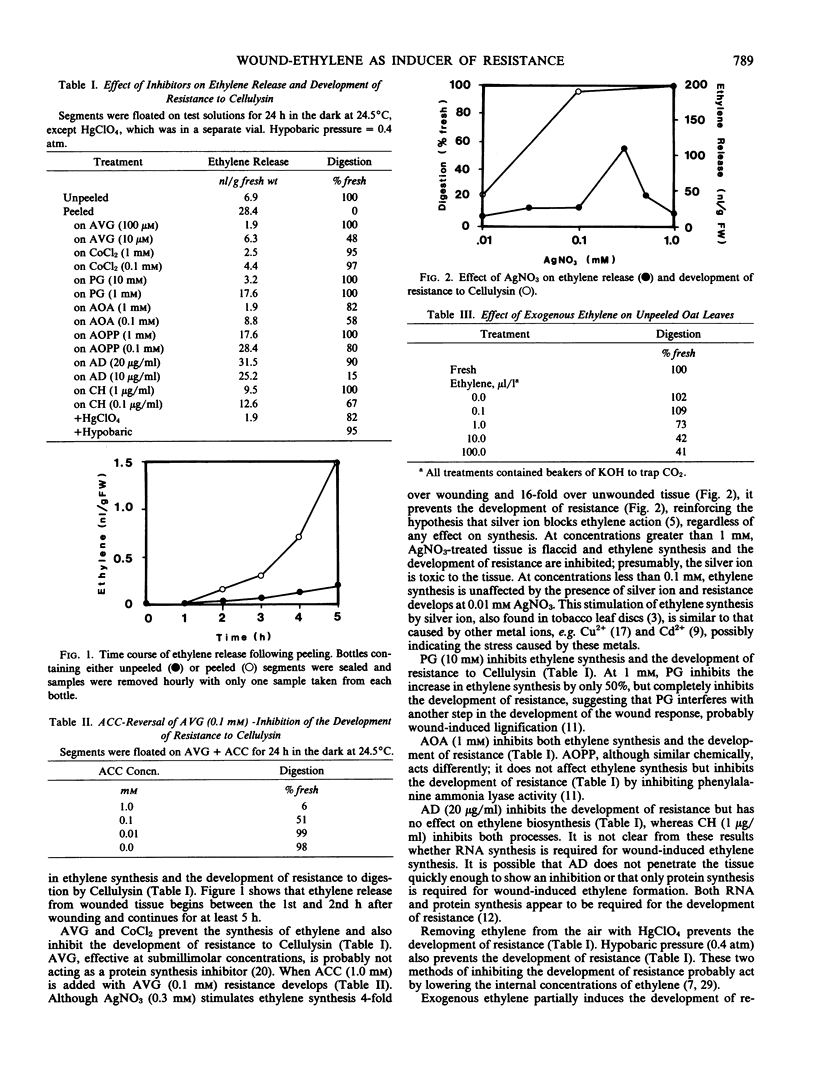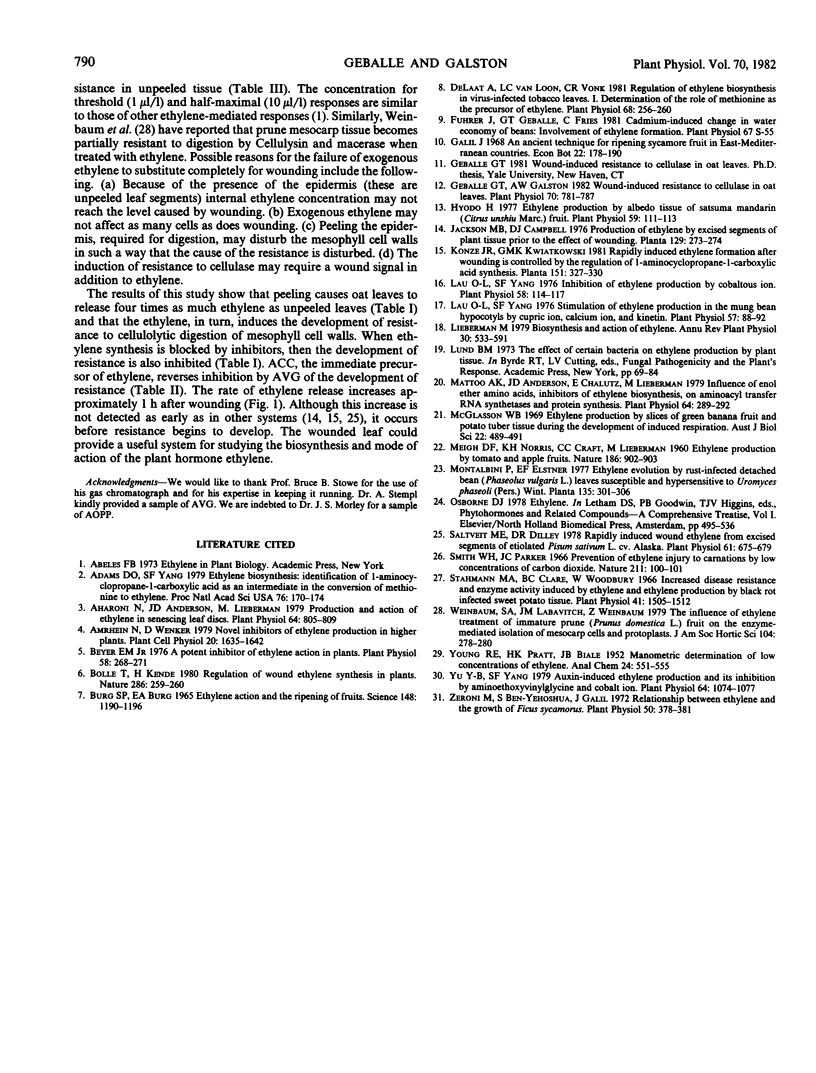Abstract
Peeling the abaxial epidermis from oat leaves (Avena sativa var. Victory) induces the formation of wound ethylene and the development of resistance to cellulolytic digestion of mesophyll cell walls. Ethylene release begins between 1 and 2 hours after peeling in the light or dark. Aminoethoxyvinylglycine (AVG, 0.1 millimolar), CoCl2 (1.0 millimolar), propyl gallate (PG, 1.0 millimolar) or aminooxyacetic acid (AOA, 1.0 millimolar) inhibits, whereas AgNO3 stimulates wound ethylene formation. Incubation on inhibitors of ethylene biosynthesis (AVG, CoCl2, PG, AOA) or action (AgNO3, hypobaric pressure or the trapping of ethylene with HgClO4) also prevents the development of wound-induced resistance to enzymic cell wall digestion. 1-Aminocyclopropane-1-carboxylic acid (ACC, 1.0 millimolar) reverses AVG (0.1 millimolar) inhibition of the development of resistance. Exogenous ethylene partially induces the development of resistance in unwounded oat leaves.
These results suggest that peeling of oat leaves induces ethylene biosynthesis, which in turn effects changes in the mesophyll cells resulting in the development of resistance to cellulolytic digestion.
Full text
PDF


Selected References
These references are in PubMed. This may not be the complete list of references from this article.
- Adams D. O., Yang S. F. Ethylene biosynthesis: Identification of 1-aminocyclopropane-1-carboxylic acid as an intermediate in the conversion of methionine to ethylene. Proc Natl Acad Sci U S A. 1979 Jan;76(1):170–174. doi: 10.1073/pnas.76.1.170. [DOI] [PMC free article] [PubMed] [Google Scholar]
- Aharoni N., Anderson J. D., Lieberman M. Production and action of ethylene in senescing leaf discs: effect of indoleacetic Acid, kinetin, silver ion, and carbon dioxide. Plant Physiol. 1979 Nov;64(5):805–809. doi: 10.1104/pp.64.5.805. [DOI] [PMC free article] [PubMed] [Google Scholar]
- BURG S. P., BURG E. A. ETHYLENE ACTION AND THE RIPENING OF FRUITS. Science. 1965 May 28;148(3674):1190–1196. doi: 10.1126/science.148.3674.1190. [DOI] [PubMed] [Google Scholar]
- Beyer E. M. A potent inhibitor of ethylene action in plants. Plant Physiol. 1976 Sep;58(3):268–271. doi: 10.1104/pp.58.3.268. [DOI] [PMC free article] [PubMed] [Google Scholar]
- Geballe G. T., Galston A. W. Wound-induced resistance to cellulase in oat leaves. Plant Physiol. 1982 Sep;70(3):781–787. doi: 10.1104/pp.70.3.781. [DOI] [PMC free article] [PubMed] [Google Scholar]
- Hyodo H. Ethylene Production by Albedo Tissue of Satsuma Mandarin (Citrus unshiu Marc.) Fruit. Plant Physiol. 1977 Jan;59(1):111–113. doi: 10.1104/pp.59.1.111. [DOI] [PMC free article] [PubMed] [Google Scholar]
- Lau O. L., Yang S. F. Inhibition of ethylene production by cobaltous ion. Plant Physiol. 1976 Jul;58(1):114–117. doi: 10.1104/pp.58.1.114. [DOI] [PMC free article] [PubMed] [Google Scholar]
- Lau O. L., Yang S. F. Stimulation of ethylene production in the mung bean hypocotyls by cupric ion, calcium ion, and kinetin. Plant Physiol. 1976 Jan;57(1):88–92. doi: 10.1104/pp.57.1.88. [DOI] [PMC free article] [PubMed] [Google Scholar]
- Mattoo A. K., Anderson J. D., Chalutz E., Lieberman M. Influence of enol ether amino acids, inhibitors of ethylene biosynthesis, on aminoacyl transfer RNA synthetases and protein synthesis. Plant Physiol. 1979 Aug;64(2):289–292. doi: 10.1104/pp.64.2.289. [DOI] [PMC free article] [PubMed] [Google Scholar]
- Saltveit M. E., Dilley D. R. Rapidly Induced Wound Ethylene from Excised Segments of Etiolated Pisum sativum L., cv. Alaska: II. Oxygen and Temperature Dependency. Plant Physiol. 1978 Apr;61(4):675–679. doi: 10.1104/pp.61.4.675. [DOI] [PMC free article] [PubMed] [Google Scholar]
- Stahmann M. A., Clare B. G., Woodbury W. Increased disease resistance and enzyme activity induced by ethylene and ethylene production of black rot infected sweet potato tissue. Plant Physiol. 1966 Nov;41(9):1505–1512. doi: 10.1104/pp.41.9.1505. [DOI] [PMC free article] [PubMed] [Google Scholar]
- Yu Y. B., Yang S. F. Auxin-induced Ethylene Production and Its Inhibition by Aminoethyoxyvinylglycine and Cobalt Ion. Plant Physiol. 1979 Dec;64(6):1074–1077. doi: 10.1104/pp.64.6.1074. [DOI] [PMC free article] [PubMed] [Google Scholar]
- Zeroni M., Ben-Yehoshua S., Galil J. Relationship between Ethylene and the Growth of Ficus sycomorus. Plant Physiol. 1972 Sep;50(3):378–381. doi: 10.1104/pp.50.3.378. [DOI] [PMC free article] [PubMed] [Google Scholar]
- de Laat A. M., van Loon L. C. Regulation of Ethylene Biosynthesis in Virus-Infected Tobacco Leaves : I. DETERMINATION OF THE ROLE OF METHIONINE AS THE PRECURSOR OF ETHYLENE. Plant Physiol. 1981 Jul;68(1):256–260. doi: 10.1104/pp.68.1.256. [DOI] [PMC free article] [PubMed] [Google Scholar]


